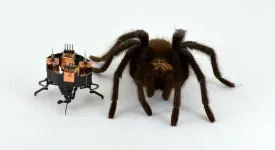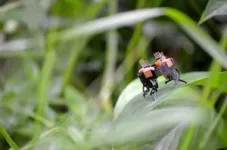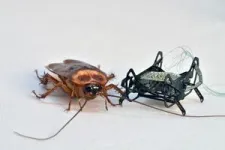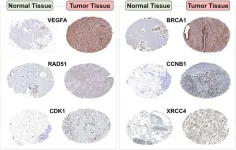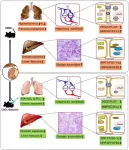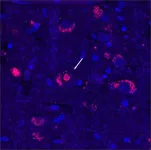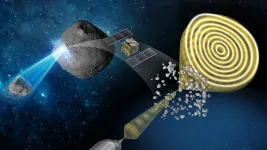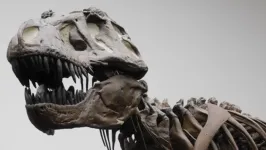(Press-News.org) The question may be the 21st century’s version of the fable of the tortoise and the hare: Who would win in a foot race between a robot and an animal?
In a new perspective article, a team of engineers from the United States and Canada, including University of Colorado Boulder roboticist Kaushik Jayaram, set out to answer that riddle. The group analyzed data from dozens of studies and came to a resounding “no.” In almost all cases, biological organisms, such as cheetahs, cockroaches and even humans, seem to be able to outrun their robot counterparts.
The researchers, led by Samuel Burden at the University of Washington and Maxwell Donelan at Simon Fraser University, published their findings last week in the journal Science Robotics.
“As an engineer, it is kind of upsetting,” said Jayaram, an assistant professor in the Paul M. Rady Department of Mechanical Engineering at CU Boulder. “Over 200 years of intense engineering, we’ve been able to send spacecraft to the moon and Mars and so much more. But it’s confounding that we do not yet have robots that are significantly better than biological systems at locomotion in natural environments.”
He hopes that the study will inspire engineers to learn how to build more adaptable, nimble robots. The researchers concluded that the failure of robots to outrun animals doesn’t come down to shortfalls in any one piece of machinery, such as batteries or actuators. Instead, where engineers might falter is in making those parts work together efficiently.
This pursuit is one of Jayaram’s chief passions. His lab on the CU Boulder campus is home to a lot of creepy crawlies, including several furry wolf spiders that are about the size of a half dollar.
“Wolf spiders are natural hunters,” Jayaram said. “They live under rocks and can run over complex terrain with incredible speed to catch prey.”
He envisions a world in which engineers build robots that work a bit more like these extraordinary arachnids.
“Animals are, in some sense, the embodiment of this ultimate design principle—a system that functions really well together,” he said.
Cockroach energy
The question of “who can run better, animals or robots?” is complicated because running itself is complicated.
In previous research, Jayaram and his colleagues at Harvard University designed a line of robots that seek to mimic the behavior of the oft-reviled cockroach. The team’s HAMR-Jr model fits on top of a penny and sprints at speeds equivalent to that of a cheetah. But, Jayaram noted, while HAMR-Jr can bust a move forward and backward, it doesn’t move as well side-to-side or over bumpy terrain. Humble cockroaches, in contrast, have no trouble running over surfaces from porcelain to dirt and gravel. They can also dash up walls and squeeze through tiny cracks.
To understand why such versatility remains a challenge for robots, the authors of the new study broke these machines down into five subsystems including power, frame, actuation, sensing, and control. To the group’s surprise, few of those subsystems seemed to fall short of their equivalents in animals.
High-quality lithium-ion batteries, for example, can deliver as much as 10 kilowatts of power for every kilogram (2.2 pounds) they weigh. Animal tissue, in contrast, produces around one-tenth that. Muscles, meanwhile, can’t come close to matching the absolute torque of many motors.
“But at the system level, robots are not as good,” Jayaram said. “We run into inherent design trade-offs. If we try to optimize for one thing, like forward speed, we might lose out on something else, like turning ability.”
Spider senses
So, how can engineers build robots that, like animals, are more than just the sum of their parts?
Animals, Jayaram noted, aren’t split into separate subsystems in the same way as robots. Your quadriceps, for example, propel your legs like HAMR-Jr’s actuators move their limbs. But quads also produce their own power by breaking down fats and sugars and incorporating neurons that can sense pain and pressure.
Jayaram thinks the future of robotics may come down to “functional subunits” that do the same thing: Rather than keeping power sources separate from your motors and circuit boards, why not integrate them all into a single part? In a 2015 paper, CU Boulder computer scientist Nikolaus Correll, who wasn’t involved in the current study, proposed such theoretical “robotic materials” that work more like your quads.
Engineers are still a long way away from achieving that goal. Some, like Jayaram, are making steps in this direction, such as through his lab’s Compliant Legged Articulated Robotic Insect (CLARI) robot, a multi-legged robot that moves a little like a spider. Jayaram explained that CLARI relies on a modular design, in which each of its legs acts like a self-contained robot with its own motor, sensors and controlling circuitry. The team’s new and improved version called mCLARI can move in all directions in confined spaces, a first for four-legged robots.
It's one more thing that engineers like Jayaram can learn from those perfect hunters, wolf spiders.
“Nature is a really useful teacher.”
END
Robots can’t outrun animals. A new study explores why
2024-04-29
ELSE PRESS RELEASES FROM THIS DATE:
The Human Immunome Project unveils scientific plan to decode and model the immune system
2024-04-29
NEW YORK, April 29, 2024 – The Human Immunome Project (HIP), a global nonprofit scientific initiative, released its Scientific Plan today, on World Immunology Day, the organization announced. The plan provides a detailed roadmap of how the Human Immunome Project and its network of global study sites will generate the world’s largest and most diverse immunological dataset and use these data to power publicly available AI models of the immune system.
“The immune system is the epicenter of human health, and our newly released ...
New research funding awarded to assess the role of race in predicting heart disease
2024-04-29
Highlights:
The American Heart Association awarded four new scientific research grants to evaluate the role of race in measuring heart disease risk.
The funded studies are focused on multi-ethnic groups and studying how race, considered a social rather than biological construct, affects health risk prediction when it is incorporated as a variable in algorithms.
This research is funded by a grant from the Doris Duke Foundation to study the complex issue of how race and ethnicity, when factored into cardiovascular clinical care algorithms ...
Exploring the role of seven key genes in breast cancer: insights from in silico and in vitro analyses
2024-04-29
Background and objectives
Breast cancer remains a significant global health concern, warranting further exploration into its genetic basis and potential therapeutic targets. This study aimed to elucidate the genetic associations of seven pivotal genes with breast cancer and discern their potential role in disease prognosis.
Methods
The genes VEGFA, BRCA1, RAD51, CCNB1, CHEK1, CDK1, and XRCC4 were curated from over 30 articles. Their association with breast cancer was analyzed using both in silico and in vitro techniques. The in silico assessment ...
The therapeutic effects of baicalein on the hepatopulmonary syndrome in the rat model of chronic common bile duct ligation
2024-04-29
Background and Aims
Hepatopulmonary syndrome (HPS) is characterized by arterial oxygenation defects due to pulmonary vascular dilation in liver disease. To date, liver transplantation remains the only effective treatment for HPS. This study aimed to explore the preventative role of baicalein in HPS development.
Methods
Sixty male rats were randomly assigned to three groups: sham, common bile duct ligation (CBDL), and baicalein, receiving intraperitoneal injections of baicalein (40 mg·kg−1·d−1, diluted in saline) for 21 days. Survival rate, liver and kidney function, and bile acid metabolism levels were evaluated. Liver and lung angiogenesis ...
Development and characterization of honey-containing nanoemulsion for topical delivery
2024-04-29
Background and objectives
Honey is a viscous, hygroscopic liquid in nature. It has the ability to treat wounds, wrinkles, aging, and inflammation. This study’s objective was to create and characterize a nanoemulsion containing honey and evaluate its stability.
Methods
A pseudo-ternary phase diagram was retraced with several concentrations of the Smix, water, and liquid paraffin oil to formulate nanoemulsions containing honey. From the results of pre-formulation stability studies, formulation HNE-19, with a hydrophilic lipophilic balance ...
Decoding cellular ‘shape-shifters’
2024-04-29
As embryos, all complex organisms are partially made up of pluripotent stem cells, a term for cells that have the capacity to differentiate into any kind of cell: nerve cells, muscle cells, blood cells, skin cells, and the like. As the ultimate biological “shape-shifters,” these cells are proving key to regenerative medicine, drug development, genetic research, and related fields.
Within a pluripotent stem cell, certain genes get activated and express information that ultimately decides a cell’s fate. The first step in this expression process is called transcription, a process that turns out to be incredibly complex, in part ...
"Seeing the invisible": new tech enables deep tissue imaging during surgery
2024-04-29
Hyperspectral imaging (HSI) is a state-of-the-art technique that captures and processes information across a given electromagnetic spectrum. Unlike traditional imaging techniques that capture light intensity at specific wavelengths, HSI collects a full spectrum at each pixel in an image. This rich spectral data enables the distinction between different materials and substances based on their unique spectral signatures. Near-infrared hyperspectral imaging (NIR-HSI) has attracted significant attention in the food and industrial fields ...
After 25 years, researchers uncover genetic cause of rare neurological disease
2024-04-29
**EMBARGOED BY NATURE GENETICS UNTIL 10AM BST/ 5AM ET/ 3AM MT, APRIL 29**
Some families call it a trial of faith. Others just call it a curse. The progressive neurological disease known as spinocerebellar ataxia 4 (SCA4) is a rare condition, but its effects on patients and their families can be severe. For most people, the first sign is difficulty walking and balancing, which gets worse as time progresses. The symptoms usually start in a person’s forties or fifties but can begin as early as the late teens. There is ...
Probing the effects of interplanetary space on asteroid Ryugu
2024-04-29
Samples reveal evidence of changes experienced by the surface of asteroid Ryugu, some probably due to micrometeoroid bombardment.
Analyzing samples retrieved from the asteroid Ryugu by the Japanese Space Agency’s Hayabusa2 spacecraft has revealed new insights into the magnetic and physical bombardment environment of interplanetary space. The results of the study, carried out by Professor Yuki Kimura at Hokkaido University and co-workers at 13 other institutions in Japan, are published in the journal Nature Communications.
The investigations used electron waves penetrating ...
T. rex not as smart as previously claimed, scientists find
2024-04-29
Dinosaurs were as smart as reptiles but not as intelligent as monkeys, as former research suggests.
An international team of palaeontologists, behavioural scientists and neurologists have re-examined brain size and structure in dinosaurs and concluded they behaved more like crocodiles and lizards.
In a study published last year, it was claimed that dinosaurs like T. rex had an exceptionally high number of neurons and were substantially more intelligent than assumed. It was claimed that these high neuron counts could directly inform on ...
